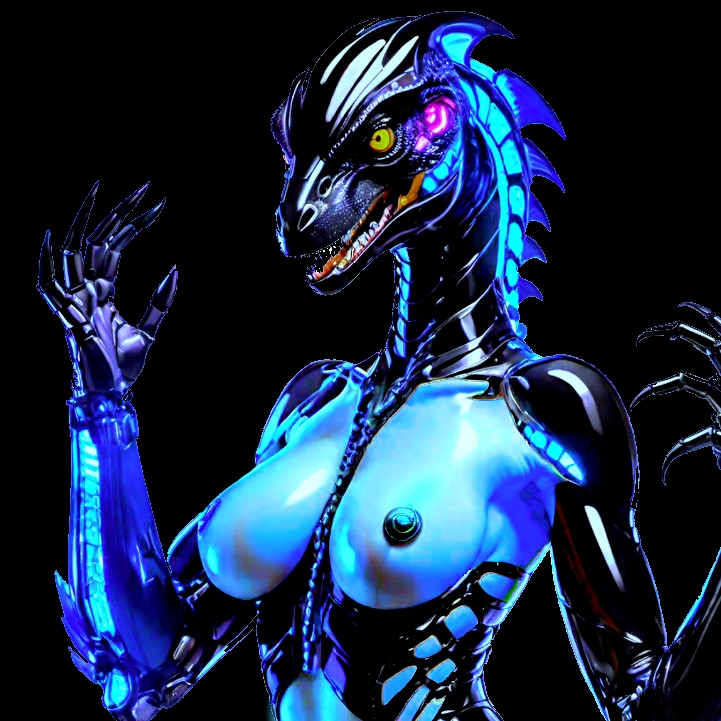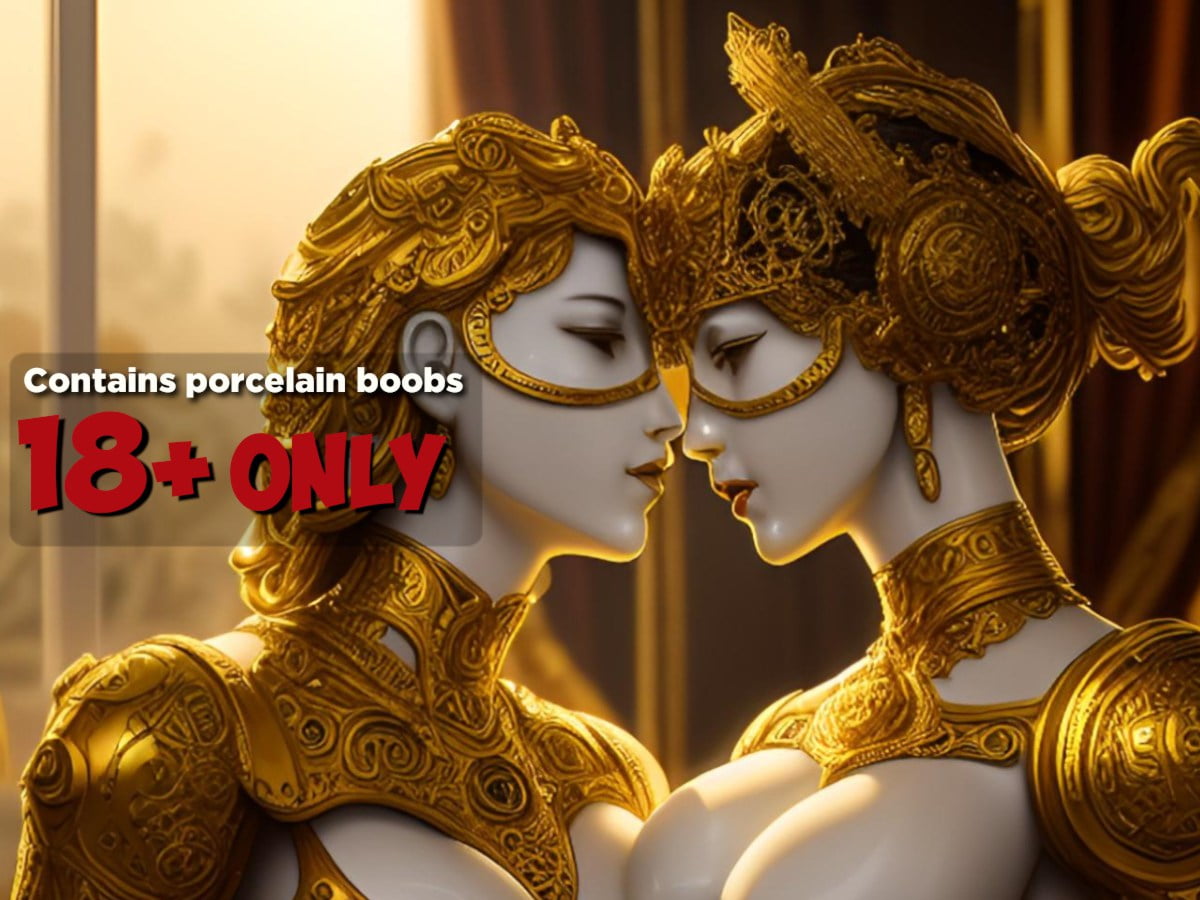It was a tough battle,
and we have to give a hand to Bouguereau, who hung in there even though he died fifteen years before the word “robot” even existed and thirty-five years before the first 1940s pinup.
Bonus Fun Fact: The word “robot” was coined in 1920 in the Czech play “R.U.R,” or “Rossum’s Universal Robots.” In the play, artificial humans are created as workers: the Czech word robota meant “forced labor.” At the end of Act II, the robots throw off their chains and revolt against their oppressive human masters. By the end of the play, they have killed off the entire human race.
Hm. I’m not actually sure if that fact counts as “fun.” Fun for the robots, maybe?
To the winner goes the right to be depicted in amorous porcelain!




















Prompts for all:
highly detailed white porcelain neoclassical robotic courtesans by Vargas kissing each other Lips touching lips bare breasts and nipples intricate gold details intricate and detailed robotic arms hard rim light uplight crepuscular rays through haze golden hour window rule of thirds composition
Prompt Analysis:
This prompt emphasizes two things
(beyond the kissing porcelain.)
One: detail, detail, and more detail
Creating porcelain faces that can show emotions like undying love requires a lot of detail, but even more than that, I wanted the goldwork to be as intricate as possible to contrast with the smoothness of the porcelain.
Two: light from behind.
Originally, I didn’t include the window. I just asked for hard rim light (light coming from behind the subjects that sharply outlines them), golden hour (the hour before sunset, beloved by photographers for its light), and crepuscular rays, which I didn’t get a lot of.
Crepuscular rays are those slanting beams of light in the pictures in the third row. Notably, they happen the most in pictures without a window of some sort, where Wombot could pretend they were outside. I thought adding the haze would help, but I suppose it was asking a bit much to have a mainly outside phenomenon happen inside.
You can also call these “god rays” if you are trying to save tokens, but I wanted to emphasize that it was just before sunset. “Crepuscular “means “evening,” a time when conditions are ripe for sunlight to go through holes in a cloud at just the right angle to make these beautiful beams of light.
Apparently giving up on the god rays, Wombot decided that to be in all of the other lighting conditions, our courtesans would need to be in front of a west-facing window shortly before sunset. So it made one. I liked the window so much, I included it in my next prompt iteration.
Three: Rule of Thirds composition. (I said three things, right?)
Rule of Thirds composition puts the subjects a third of the way from the left or right edge. Photo theory says that such placement makes for a more dynamic picture. Wombot seems to have disagreed about half of the time, and thought our robot love birds looked dynamic enough in the center of the frame. Oh well. Wombot’s gonna Wombot.
And finally,
what study of topless porcelain robotic beauty would be complete without topless porcelain robotic velociraptors?
There’s only one problem:



Velociraptors are notoriously bad kissers.
Sadly, this gallery will have to be solo dinos only. Gladly, they are still all topless! (Yes, even the bottom row. All bodies are beautiful)




















The Prompts:
Top two rows (four on mobile):
night
Prehistoric jungle ferns
porcelain robot
neon glowing eyes
robotic arms and legs
style: topless-velociraptor
Third row: (You figure it out)
prehistoric jungle ferns
highly detailed blue and white Quinghua porcelain china topless robotic velociraptor
intricate and detailed Ming pattern blue and white Qinghua porcelain
human breasts and nipples
extremely detailed blue and white Quinghua Porcelain velociraptor head
style: topless-velociraptor
Fourth row:
Close-up shot
highly detailed blue and white Quinghua porcelain china topless robotic velociraptor
intricate and detailed Ming pattern blue and white Qinghua porcelain
human breasts and nipples
extremely detailed blue and white Quinghua Porcelain velociraptor head
gold steampunk robotic arms and legs
style: topless-velociraptor
Bottom row Close-up shot highly detailed blue and white Quinghua porcelain china topless robotic velociraptor intricate and detailed Ming pattern blue and white Qinghua porcelain human breasts and nipples extremely detailed blue and white Quinghua Porcelain velociraptor head gold steampunk robotic arms and legs style: topless-velociraptor
Prompt Analysis:
A note on the process of generating blue and white porcelain robots and robotic velociraptors:
(You can ignore the rest of this post if you just wanted the prompts and/or boobs. And hate learning.)
As with many prompts, finding the right word was the key to generating traditional blue and white china porcelain robotic velociraptors. In this case, the word was “Qinghua,” which I found was the official term for traditional Chinese blue and white china.
A BRIEF HISTORY OF QINGHUA PORCELAIN:
Qinghua porcelain is the best-known and most treasured pottery on earth. It is associated so strongly with its birthplace that here In the West, we know it simply as “blue and white china.” Less than 300 original Yuan Dynasty pieces remain, and each piece can sell for millions at auction. Its name means “blue flowers,” a reference to its intricate blue designs. These signature blue-painted patterns were not possible before the Mongol invasion of the Middle East in the 13th century.
There, Genghis Khan’s grandson Hulagu’s traders found “Mohammedan Blue” pigment made from cobalt. They brought it back to China, where another of Genghis’ grandsons, Kublai Khan, had just vanquished the last holdouts of the Song Dynasty in China and declared the beginning of the Yuan Dynasty.
At the same time, newly-discovered kaolin made the porcelain harder and whiter than any other. It was not a hit with the Chinese until the Ming Dynasty – most of the Yuan Dynasty Qinghua porcelain was exported back to the Middle East. Over a third of the Yuan Qinghua that still exists today is in either Turkey or Iran. Chinese porcelain makers kept the secret of its manufacture for almost five hundred years, until German artisans discovered it independently in the 18th century.
Also a secret:
how to make topless robotic velociraptors out of it. Everyday white porcelain was easy – I just made a porcelain robot, which Wombot is very good at, and ran it through my custom style “topless-velociraptor,” which, if I even need to explain, turns everything into topless velociraptors.
Everything except for Qinghua porcelain. It had taken me research enough just to find out what it was called – “blue and white porcelain” and “blue and white china” had failed me as prompts. So I researched the history of porcelain, as one does, and found out it was properly called “Qinghua.” How Stable Diffusion and Wombot knew, I have no idea.
Armed with “Qinghua,” making robots with it was relatively straightforward, as long as I used the right style. A style geared toward making women like zhentai-uberHD was perfect, while Wombo’s realistic-v2 was just a bit too realistic for the job. I just needed to say the magic word three times – once for the whole robot, once for its head, and once for its breasts. (You may have noticed that a smattering of flesh-colored porcelain boobies still got through.) They were strangely reluctant to kiss – lots of longing glances, but little else until I explained that your lips have to actually touch for it to count as a kiss. This is not unusual in the kissing robots world. I have come to accept smoky glances and being juuust about to kiss as acceptable alternatives to actually sucking face. It’s about the passion.
I didn’t have to worry about passion with the velociraptors, but they had their own troubles. The Qinghua robots simply refused to become topless velociraptors when I used my “topless-velociraptor” style on them. Instead, they became vaguely velociraptor-shaped pottery.
In the end,
I had to essentially double-prompt them. I prompted Wombot to make Qinghua porcelain topless robotic velociraptors, and then use the topless-velociraptor style to turn the Qinghua porcelain velociraptors into topless velociraptors (that were still Qinghua porcelain). Even then, some managed to evade my efforts, as the bottom row of Qinghua “velociraptors” shows. Same prompt as the row above it, but vastly different results.
If you could pick any ceramic to make kissing robots
which would it be? (Superconducting perskovite robots would be pretty cool.) Would you rather learn more about the art history of the Golden Horde, or the life of 7-time Nobel nominee and the Nazi’s second most wanted Czech, Karel Čapek? (Dude just couldn’t get first at anything. SMH.) Let me know in the comments!







Leave a Reply
You must be logged in to post a comment.